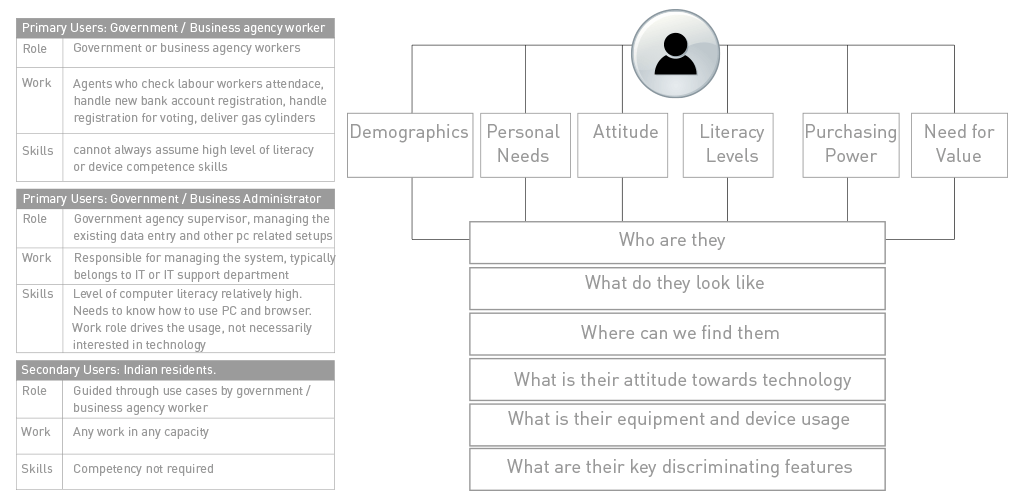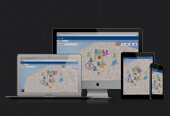DIGITAL IDENTITY
Enterprise | Mobile | Desktop
Digital Identity: A global phenomenon; Indian context.
The ability to prove a person’s identity successfully in both the real and virtual world can help governments across the globe target services and subsidies to individuals, who rightfully deserve them. In India, the Aadhaar (Unique ID, India’s next generation national ID project) initiative, is one such government project aimed at providing a secure and robust identification infrastructure that will help people prove their identity and the government to disseminate services directly to rightful Indian citizens.
The Challenge
Design a mobile device to allow government organizations identify and autheniticate Indian citizens and prepare a mobile application framework that follows the Indian visual language, is universally acceptable, and can let any designer/developer, design and develop a service application for UIDAI.
A Need for an Unique identity across the world
Many countries use a national unique identifier to effectively deliver government and private services.
Perhaps the best known among them is the Social Security Number (SSN), in the United States. Agencies at all levels of government frequently collect and use SSNs to administer their programs and verify applicants’ eligibility for services and benefits. China, too, makes identity cards mandatory for all citizens above 16. The identity card is also the only acceptable legal document to obtain residence permit, employment, open bank accounts, passport, driver license, and application for tertiary education and technical colleges. Similarly, the INSEE code in France, the personal identity code in Finland and National Identity Document in Argentina are all examples of national identity programs.
Therefore the need to establish an individual’s identity is paramount and countries across the world are trying to do so through various programs.


Primary research-- Usability, UI & Form Factor Exploration, Use Context Identification
Participant Profiles : A total of 10 participants, 5 from a APL (Above Poverty Line) background and 5 from BPL (Below Poverty Line). The reason for this segregation was to see how participants from different economic groups availed services and what kinds of differences were there in the kinds of ID documents they possessed.
Method:
A detailed interview was conducted with each of the participants in their local contexts.
ID Artefact Mapping – documenting all the ID artefacts held by the participant and mapping out how they acquired and used that document to avail services. Also finding out about the roadblocks and abuse scenarios to using ID documents/artefacts.
Usability test done with various form factors of handheld devices including POS terminals.
Form factor exercise to see favoured positions of scanners on the device.


Key use patterns for mobile authentication
Service transparency & record tracking
Mobile device given to individual government workers for making all transactions transparent involving distribution of goods and services. Key government services: Public Distribution System (ration shop, gas agency)
Proof of service entitlement
Mobile device for information gathering and retrieval for field workers upon UID authentication, updating individual citizen’s service entitlement and data directly to online server. Key services: Voting, Healthcare, Police, NREGA, PDS delivery, Banking
Authentication agency for consumer services
Government’s providing authentication services for offline & online businesses in private sector. Key sectors: Private businesses requiring secure user authentication


Design for UID based applications: Target Audience
Though the Aadhaar program is a pan India program, in the initial stages the people likely to benefit the most are the rural and poor Indian people, who will be using agent assisted authentication to avail Aashaar related services.


The three pronged design approach
To do this effectively, and make it easily accessible, a range of Aadhaar enabled applications need to be designed. We made sure that these applications are easy to use, localize and follow a common design pattern, language and framework that a developer/designer can easily replicate and the user can easily understand.
One Design Toolkit
1) UI Library Design
A customizable UI library with full theme support to design and develop any Aadhar application.
2) Fingerprint Guidance UI
A detailed fingerprint guidance UI with all detailed usecases for single and multiple finger scans including error scenarios.
3) Authentication Portal Design
All important usecases that allow the application to talk to a robust backend through two configurable customer portals are also designed and developed.
Benefits
User
1) Same UI across any Aadhar application.
2) Easy to understand with a steep learning curve as all UI elements will be familiar.
3) Same authentication process will save time.
4) A distincy indian visual language
Designer & Developer
1) All elements required to design an application available in a single, easy to use toolkit.
2) Timesaving, fast, lightweight and open source.
3) Complete documentation with all code and open files.
4) Completely configurable for any device or screen size.
The UI Library Design
The UI library is simple, using only the most widely used components and interactions to accomplish any tasks easily. (18 High level components - ~120 varied combinations of visual appearances). Animation engine is integrated to display animated Icons.
All components will work for all screen resolution, including both landscape and portrait modes, making the library device independent.
The application designer/developer can create own theme just by modifying theme text file. Over 240 items can be controlled by just modifying the theme file.
The library has a rich localisation capabilities supporting 14 Indian languages
Size:
The components in the library are fully configurational. The application designer / developer can modify the sizes based on the application requirement and also to match different screen sizes.
Color and Theme Support:
The toolkit comes with the default Nokia Blue Theme. However these theme colors are also configurational and based on application brand colors can be customized.
Simple Yet Detail Oriented:
The UI Library is simple, using only the most widely used components and interactions to let you accomplish any task easily. The library is detail oriented, an attribute borrowed from Indian art and Indian street graphics. A simple example being the text input field which has three layers, including two layers of borders which are a pixel wide to give depth


Fingerprint Scanning UI
Fingerprint Scanning UI will help user to scan their finger(s) and the scan data can then be used for various purposes by the native or the 3rd party application.
Examples: Resident Authentication for AADHAAR Services ( financial inclusion, lpg delivery)
This feature can be accessed by any of the above-mentioned application or API’s. The UI library will support all elements for the guidance UI, thus making it device and form factor independent. Example: attach a finger print scanner to your existing phone, install Aadhaar application with Fingerprint Scanning Guidance, and you are good to go.


AUA - Aadhaar Authentication Servers - High level use cases and portal design
Just like the UI library, a complete specification document, is created for anyone who wants to create an AUA and corresponding portals.
The specification document contains:
- Wireframes for all the important UIDAI usecases
- Visual design, theme files with specifications for each of the components
- Colour and theme files
- HTML and CSS which can be used and can easily be modified making the portal designs match client application requirement.
- All required images to render the HTML seamlessly.
A detailed usability study was also conducted based on persona’s of actual users who were most likely to use portals. The feedback from the study was included and subsequent changes made to the portals.






